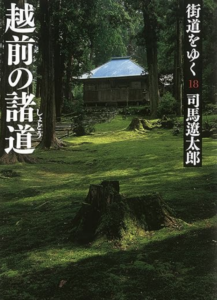Life Tips & Miscellaneous Travel and History Zen Philosophy and History Art and Sport Navigation of this blog
Summary
Travel is an act for human beings to visit new places and experience different cultures and histories. Through travel, people can actually feel historical events and people’s lives by visiting historical places and cultural heritage sites, and can gain a deeper understanding of history and broaden their own perspectives. In this section, we will discuss the historical background of the trip and the places visited based on Ryotaro Shiba’s “Kaido yuku” (On the Road) about this journey and history.

Kaidou wo yuku Vol.18 Kitaguni kaidou
In the previous article, we discussed Tanba-Sasayama Highway, In this article, we will discuss the Hokkoku Kaido and its side roads.
The Northern Highway, Its Side Routes and the Mysteries of Ancient Japan
This trip will start from Kaizu (lower middle star in the figure) on the northern shore of Lake Biwa, follow the official road of the Nara Period, pass through Border and Hikita (middle star in the figure), Tsuruga (upper middle star in the figure), Takefu, and head south on the Hokkoku Highway, crossing Tochinokitogi Pass to view Lake Yogo (lower right star in the figure) and Kinomoto. The related history is that of the ancient exchange with Bohai Sea in northeastern China, Emperor Tsugitai, who is predicted to have greatly changed the ancient emperor system, and Katsuie Shibata and Hideyoshi Toyotomi in the Warring States Period.

The three prefectures of Hokuriku, called Koshi in ancient times, were independent from the Kinai region, and a barrier called “Airachi no Seki” was apparently built on the border between Nara/Kyoto and Hokuriku. It is said to have been located in the vicinity of present-day Arachi Mountain, but its current location is unknown. Other than Airachi-no-seki, Suzuka and Fuwa are the other two important ancient seals (Sanseki).

Both of the other barrier stations (Suzuka and Fuwa) were oriented toward the east, making them the eastern frontier for the ancient Kinai regime. The original Northern Highway is said to have started from Fuwa (present-day Sekigahara), but Ryotaro Shiba and others chose to start from Kaizu, at the northern end of Lake Biwa.
Until the end of the Edo period, maritime traffic was mainly on the Sea of Japan route, as the term “Kitamaebune” (Kitamae-bune) implies, because there were few robust vessels that could cross the Pacific Ocean. Products from Osaka were transported via the Seto Inland Sea to the Sea of Japan around Shimonoseki and then to Ezo, and for this reason, the ports on the Sea of Japan side were crowded, with Echizen Tsuruga (present-day Fukui Prefecture) being the most prosperous among them.
Rice and marine products were unloaded here and transported by land to the northern shore of Lake Biwa, then shipped again from the ports of Shiotsu and Kaizu to Otsu, from where they were transported to Osaka and Kyoto.
In Kaido Yuku, we focus on this route and begin with the story of exchange between Japan and the country of Bohai, which existed in the northeastern part of China in ancient times (around 700-900). The Bohai Kingdom visited Japan during the reign of Emperor Shomu (around 720). As for the route they followed, they started from Pochet Bay, which is now a Soviet territory, and entered Tsuruga, from where they passed through Aihatsu Seki and took the route of Kaizu/Otsu.
The route started from the starting point of Kaizu, which is a scenic spot with a mountainous topography that extends into the lakeshore.

From Kaizu, we headed north to Aihatsu Seki (Mt. Arimitsu). As mentioned above, no vestiges of the ancient barrier remain, but instead we find a stone monument of Shinran Shonin on the way.

After crossing the pass, we will head for Tsuruga. From Mt. Urumu, it will take about 2 hours on foot.

In the town of Tsuruga, he first visited Kebi no Matsubara.

Kebi no Matsubara is one of the three most scenic pine groves, along with Niji no Matsubara (Karatsu City, Saga Prefecture) and Miho no Matsubara (Shimizu City, Shizuoka Prefecture), and will be at the top of the list of Tsuruga’s tourist information. The group will head to the ruins of Kanegasaki Castle, located at the tip of a cape overlooking Tsuruga Bay.

Further to Matsubara Shrine in Matsubara-cho.

This is where the Mito Tengu party, a group that emerged at the end of the Edo period, was executed in large numbers, and the spirit of Takeda Kounsai, the ringleader of the Tengu party, is said to be enshrined at Matsubara Shrine as well.

Here the topic shifts from the end of the Edo period to ancient times. Emperor Keitai (継体天皇), a native of Echizen, was the 26th emperor and came to the throne around 500. He was not originally in a position to succeed to the throne (being more than four kin to his predecessor), but when his predecessor, Emperor Takeiteto, died without a successor, the Otomo and Mononobe clans, which were powerful at the time, made him the successor to the throne. Therefore, some people believe that the current imperial line does not originate from the line before Emperor Tsugitai, but from Emperor Tsugitai himself.
Various hypotheses have been proposed concerning the mysterious Emperor Tsugitai,

and have been written about in various books, such as “Ancient Messages” and “New Historiography.


In the next article, I will discuss the Miura Peninsula.


コメント